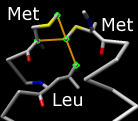what is command line for find clash chimera write to reply log
Find Clashes/Contacts 
 Find Clashes/Contacts identifies interatomic clashes and contacts based on VDW radii and user-specified criteria. Terminology:
Find Clashes/Contacts identifies interatomic clashes and contacts based on VDW radii and user-specified criteria. Terminology:
- clashes - unfavorable interactions where atoms are too shut together; close contacts
- contacts - all kinds of direct interactions: polar and nonpolar, favorable and unfavorable (including clashes)
There are several ways to start Find Clashes/Contacts, a tool in the Structure Assay and Surface/Bounden Analysis categories. It is also implemented as the command findclash.
Atoms to Check are specified by selecting atoms, clicking Designate, and indicating which interactions should be found:
- themselves - interactions amongst the designated atoms
- all other atoms (default) - interactions between the designated atoms and all other atoms
- other atoms in same model - intra-model interactions between the designated atoms and all other atoms
- second set of designated atoms - interactions between the designated atoms and a second designated set (specified by selecting atoms and clicking Designate selection as second fix)
The Disharmonism/Contact Parameters command what volition be considered a clash or contact. The overlap between 2 atoms is defined as the sum of their VDW radii minus the distance between them and minus an allowance for potentially hydrogen-bonded pairs:
overlapij = rVDWi + rVDWj – dij – assartij
- Find atoms with VDW overlap >=[ cutoff ] angstroms - pairs of atoms with overlap ≥ cutoff will be identified. A larger positive cutoff restricts the results to more astringent clashes, whereas a negative cutoff can also identify favorable contacts.
- Subtract [ allowance ] from overlap for potentially H-bonding pairs - an allowance > 0 reflects the observation that atoms sharing a hydrogen bail tin come closer to each other than would be expected from their VDW radii. The allowance is merely subtracted for pairs comprised of a donor (or donor-borne hydrogen) and an acceptor. This is equivalent to using smaller radii to characterize hydrogen-bonding interactions (for example, see Li and Nussinov, Proteins 32:111 (1998)). Equally in FindHBond, possible donor groups are hydrogen-bearing nitrogen, oxygen, and sulfur atoms, and possible acceptor groups are nitrogen, oxygen, and sulfur atoms with a lonely pair.
For detecting clashes , cutoff values of 0.iv-ane.0 Å and allowance values of 0.2-0.6 Å are generally reasonable (default disharmonism criteria 0.half-dozen and 0.iv Å, respectively).
For detecting contacts , negative cutoff values of 0.0-(–ane.0) Å with an allowance of 0.0 Å are generally reasonable (default contact criteria –0.4 and 0.0 Å, respectively).
- Ignore contacts of pairs [ North ] or fewer bonds autonomously (Northward=4 by default)
- Include intra-residual contacts (default off)
- Include intra-molecule contacts (default on) - whether to include intramolecular interactions, where a molecule is defined equally a covalently bonded set of atoms
- Select - whether to select atoms meeting the disharmonism/contact criteria (and deselect all other atoms)
- Colour [ color well ] (and color all other atoms [ color well ]) - whether to color atoms meeting and not coming together the clash/contact criteria (the default colors are red and No color, respectively; using No color reveals model-level colors)
- Draw pseudobonds of color [ color well ] and width [ linewidth ] - whether to draw pseudobonds of the specified color (default yellowish) and linewidth (default 2.0) betwixt pairs meeting the clash/contact criteria. These pseudobonds tin can exist removed with the control ~findclash. The PseudoBond Console can also exist used to shut the pseudobond grouping (named contacts) or alter its display.
- If endpoint cantlet hidden, show endpoint residue - turn on the display of residues containing a contact atom if that cantlet is non displayed initially (By default, if the cantlet on either terminate of a pseudobond representing a contact is not shown, the pseudobond itself is not shown, although it still exists; displaying the atom allows the contact pseudobond to be shown.)
The post-obit are only available for discontinuous checking (when OK/Apply clicked):
- Assign 'overlap' aspect - whether to assign the largest overlap per atom equally an attribute named overlap and open the Render by Attribute tool
- Write data to file - whether to write disharmonism/contact information to a text file. The dialog for saving the file includes a Naming style option to control how atoms volition be listed:
- simple (for case, HIS xvi.A ND1)
- command-line specifier (for case, :16.A@ND1)
- serial number (for example, 126)
- Write information to reply log - whether to write clash/contact information to the Reply Log. The Atomspec display fashion setting in the Labels preferences controls how atoms will be listed.
- when OK/Apply clicked (default) - this pick is compatible with all handling options, including attribute assignment and writing out clash/contact information. Clicking OK runs the calculation and dismisses the dialog, whereas clicking Utilize runs the adding without dismissing the dialog.
- subsequently relative motions (until dialog closed) - whenever relative motions are paused; only selection and display treatments are bachelor. Relative motions include bond rotations and translations/rotations of 1 model relative to another, as opposed to translations/rotations of all models collectively.
- continuously (until dialog closed) - during motions; only pick and brandish treatments are available
UCSF Computer Graphics Laboratory / September 2014
Source: https://www.cgl.ucsf.edu/chimera/docs/ContributedSoftware/findclash/findclash.html
Post a Comment for "what is command line for find clash chimera write to reply log"